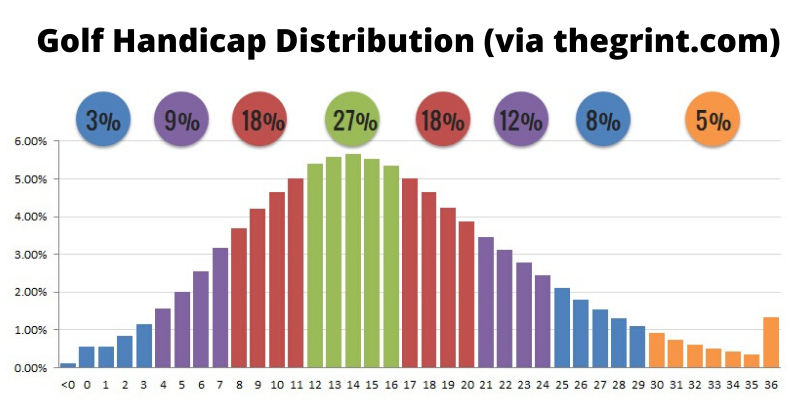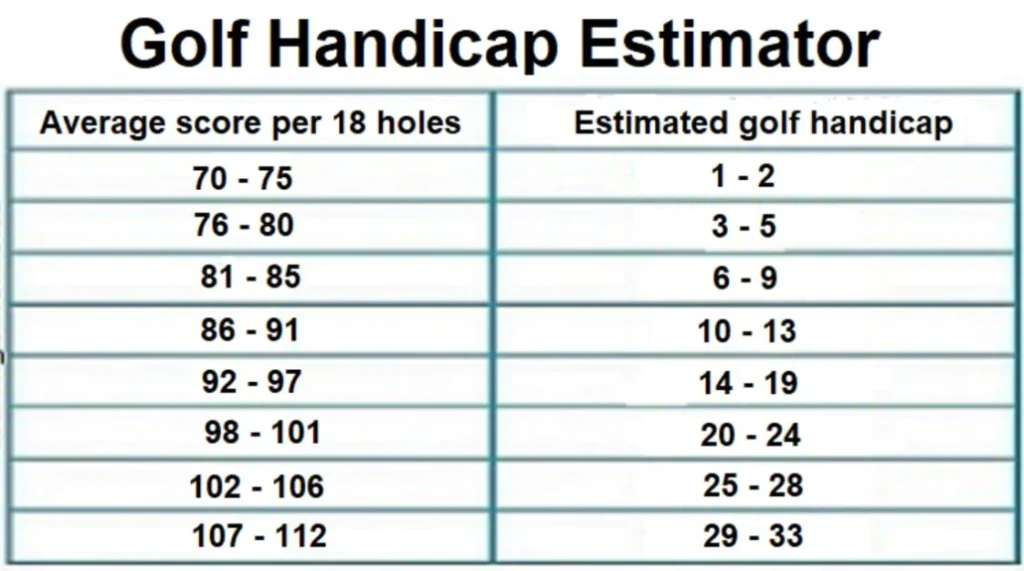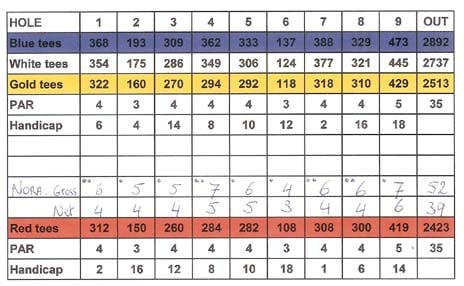How does a handicap work in golf
Key Takeaway:
- A golf handicap is a numerical rating that allows players of different skill levels to compete on a fair playing field.
- The handicap is calculated using reference data, including course ratings, slope ratings, and equitable stroke control.
- Having an official handicap provides benefits such as tracking scores, comparing net scores to course ratings, and assessing performance.
Introduction
The importance of a golf handicap in ensuring fair competition among players of different skill levels and the range of handicaps for both men and women are key aspects we will explore in this article.

Importance of a golf handicap in ensuring fair competition among players of different skill levels
The significance of a golf handicap for fair competition between players of various skill levels is immense. It’s a numerical rating that reveals a player’s ability relative to par. It allows golfers of differing skill levels to compete fairly. It gives lower skilled players extra strokes to balance the game.
Handicaps differ for men and women due to physical strength and other factors that affect performance. The handicap system strives to make the game fair for everyone. It measures a player’s progress over time and helps them understand their strengths and weaknesses.
To calculate a golf handicap, several elements are used. These include the course rating, slope rating, and equitable stroke control. These all contribute to the handicap differential, which is the difference between the adjusted gross score and the course rating/slope rating.
For an official handicap, players must join a club or organization recognized by national golf associations. They must submit qualifying rounds that meet certain criteria. Handicaps are adjusted based on recent scores.
In tournaments, maximum handicap limits are set to keep highly skilled players with low handicaps from having an unfair advantage. Handicaps allow tournament organizers to create balanced brackets and give all golfers an equal chance of success.
In conclusion, the importance of a golf handicap in ensuring fair competition cannot be stressed enough. It levels the playing field for men and women of all skill levels, allowing them to track their progress and improve their game.
Range of golf handicaps for men and women
Golf handicaps for men and women vary, based on skill level and the course’s difficulty. This numerical rating shows extra strokes, ensuring fairness between players with different abilities.

A table below illustrates the general range of golf handiaps for both men and women:
| Handicap Range | Men | Women |
| 5 or less | 1.0 or lower | 1.0 or lower |
| 6-10 | 1.1 – 5.9 | 1.1 – 5.9 |
| 11-15 | 6.0 – 11.9 | 6.0 – 14.4 |
These ranges change based on certain factors, such as course difficulty and golfer’s skill. The higher the handicap, the more extra strokes one gets, allowing them to compete with players of lower handicaps.
The World Handicap System, introduced in 2020, aims to simplify handicap calculations and have global consistency. This helps golfers around the world to compete on an equal basis.
What is a golf handicap?
A golf handicap serves as a numerical rating that accounts for extra strokes in relation to par. It plays a crucial role in assessing a player’s skill level and ensuring fair competition. Let’s explore what a golf handicap truly entails, the purpose it serves within the golfing community, and how it enables players of varying abilities to compete on an equal footing.

Definition of a golf handicap as a numerical rating indicating extra strokes compared to par
A golf handicap is a numerical rating that shows extra strokes a player is allowed versus par. It shows a player’s skill level and enables fair competition among players of different talents. It is key for equal chance of success, no matter the skill level, by giving extra strokes depending on the handicap.
Calculating the handicap involves the course rating, slope rating, and equitable stroke control. Course rating is the difficulty level under normal playing conditions, and used to establish the base score for the handicap differentials. The slope rating is for players with higher or lower handicaps. Equitable stroke control sets limits on the strokes per hole.
To calculate the handicap differential, certain formulas are applied using reference data. This takes into account the player’s score, adjusted gross score, course rating, slope rating, and equitable stroke control.
To have an official handicap, join a club or association and submit qualifying rounds. Adjustments are made from recent scores and performances within a 12-month period. Maximum handicap limits are set to prevent abuse or unfair advantage in tournaments.
An official golf handicap has many benefits. Track progress by comparing scores against assigned handicaps over time. Calculate net score by subtracting handicap from gross score. Improve the handicap by playing more rounds, practicing, and getting professional help.
The golf handicap system has evolved for fairness and standardization. The World Handicap System was introduced in 2020 to unify handicap systems and provide greater consistency and fairness.
Purpose of a handicap
A golf handicap assesses a player’s skill level and ensures fair competition between players of different abilities. It’s a numerical rating which shows how many extra strokes a player needs compared to the par of a course. Calculating a handicap allows for an even playing field, where players with various skills can compete evenly.
To determine a player’s handicap, course rating, slope rating, and equitable stroke control are all taken into account. These consider the difficulty of the course and create a standard way to compare performances across courses. This reflects a golfer’s abilities properly, allowing for fair competition between players of different skills.
Plus, having a golf handicap enables players to track progress and compare their performance over time. With an official handicap, players can compute their net score by subtracting their handicap from their gross score. This lets them compare against the course rating, helping them gauge how well they did compared to the expected standard on any course.
To improve one’s golf handicap, they can play more often to gain experience and practice specific skills that need work. Professional help from coaches or instructors can help identify areas for improvement and apply successful strategies. With consistent effort and dedication to honing skills, players can expect positive changes in their handicaps over time.
How is a golf handicap calculated?
When it comes to golf, understanding how a handicap is calculated is essential. In this section, we’ll dig into the details of the process and factors involved. From the course rating to equitable stroke control, we’ll explore how these elements play a role in determining your handicap. Get ready to uncover the formula for calculating a handicap differential and ultimately establishing your official handicap. Let’s dive in and unravel the mysteries of golf handicaps.

Process of calculating a golf handicap using reference data
Calculating a golf handicap requires reference data. Firstly, the course rating and slope rating of the specific golf course must be obtained. These ratings tell about the difficulty of the course and its impact on a player’s handicap.
Secondly, a golfer’s score in comparison to par is adjusted. This is done with the help of the equitable stroke control guidelines from the reference data. This prevents extreme scores from heavily affecting the handicap calculation.
Thirdly, a formula is used to calculate the handicap differential for each round played. This shows how well or how poorly a golfer does compared to their average performance.
Lastly, an official handicap is worked out by averaging the best differentials from a set number of rounds in the last 12 months. This is in accordance with the reference data.
Note that reference data supplies rules and formulas for handicaps for all courses and players. Following these correctly allows for fair competition and a good estimation of skill level.
Furthermore, online calculators and services are available to simplify the management of handicaps.
Factors such as course rating, slope rating, and equitable stroke control in the calculation
Course rating, slope rating, and equitable stroke control are all significant factors when calculating golf handicaps. Course rating assesses the difficulty for scratch golfers, while slope rating measures difficulty for a bogey golfer compared to a scratch golfer. Equitable stroke control dictates max scores for each hole, based on the player’s handicap.
Weather and temporary adjustments for the course should also be considered. A golfer shared their experience of playing on a championship course with tough fairways and greens. Despite playing better than usual, their score was adjusted according to the equitable stroke control guidelines. This adjustment allowed a fair representation of their performance relative to par and enabled competitive play between players of different levels.
Formula for calculating handicap
A golf handicap differential is a value that measures how a golfer’s score deviates from the standard course rating. It’s used to determine an official handicap. Using course rating, slope rating, and equitable stroke control we can calculate this differential. This helps players of different skill levels compete on equal footing.
We must also adjust for recent scores, and have maximum limits set for handicaps. This helps make sure the handicap reflects the player’s current skill level. It also means golfers can track scores over time and assess performance objectively.
To improve handicaps, play more, practice diligently, and seek help if needed.
The World Handicap System was introduced in 2020. It provides a framework for calculating and managing handicaps worldwide.
Calculating a golf handicap is like trying to unlock the secret society that assigns extra strokes to make everyone equally frustrated.
Understanding the golf handicap system
Understanding the golf handicap system: Learn how to obtain an official golf handicap, the adjustment process based on recent scores, and the maximum handicap limits. Discover how handicaps impact tournament play.
Methods and requirements for obtaining an official golf handicap, including joining a club and submitting qualifying rounds
Golf handicaps are numerical ratings that show extra strokes a player gets in comparison to par. This helps with assessing skill level and competing fairly between players of different abilities. To get an official handicap, there are unique methods and needs that must be met. To guide people, follow these five steps:
- Join a recognized golf club or association that offers handicap services. Fees need to be paid and rules and regulations must be abided.
- Submit scores from qualifying rounds to set a base for calculating the handicap index. These rounds should be played on rated courses and with other players that have handicaps.
- Once qualifying rounds are submitted, the club will calculate an initial handicap index based on the player’s scores relative to the course rating and slope rating. This takes into account ESC, which limits high hole scores.
- After obtaining the initial handicap index, it is necessary to regularly update it by submitting scores from recent rounds within a certain timeframe. This keeps the handicap reflecting current performance.
- Golf handicaps have maximum limits set by governing bodies, such as national golf associations. This is important to follow when playing tournaments or competitive events where handicaps are used for scoring.
In addition to these five steps, joining a club gives access to resources and support networks that can help with managing an official golf handicap. Additionally, there may be requirements or processes that need to be met in order to get and keep an official golf handicap.
Adjustment of handicap based on recent scores and rolling 12-month period
The golf handicap system adjusts based on scores from recent rounds and a 12-month period. This keeps the handicap up-to-date and reflects the player’s current skill level.
- The rolling 12-month period affects the handicap. Every round played changes it, showing recent performances and skill level.
- If the player scores lower than the course rating, the handicap may adjust lower, meaning they have improved.
- Conversely, if the player scores higher than the rating, the handicap may increase, meaning their skill has declined.
- To make it fair for everyone, the system considers scores, course rating, slope rating, and history.
- The 12-month period keeps the handicap stable and consistent. Changes are gradual and only show real improvements or declines.
The golf handicap system ensures fairness in competition. It allows players to compete against those with similar skills and encourages improvement. It also gives an accurate representation of a player’s ability.
Maximum handicap limits and use of handicaps in tournament play
Maximum handicap limits and the use of handicaps in tournament play are key to the golf handicap system. There are specific rules for handicap limits for players. These make sure the competition is fair and all participants have equal chances, no matter their skill level.
Organizers often set a maximum handicap for participants to keep the playing field the same. This stops highly-skilled players with low handicaps from having too much of an advantage.
By putting a cap on the maximum handicap allowed, tournaments want to make sure the competition is fair and players of different skill levels are competitive.
Using handicaps in tournament play allows participants to compete on an equal basis, taking their skill levels into account. The handicap system means each player’s score can be adjusted based on their handicap index. This adjusted score is the ‘net score’ and lets players with different skill levels compare fairly.
Organizers must follow guidelines from official governing bodies like regional golf associations or national golf federations when implementing handicaps in tournament play. This makes sure tournaments are consistent and players’ handicaps are considered properly during the competition.
Overall, it’s essential to understand the maximum handicap limits and the use of handicaps in tournament play. It encourages fair competition while allowing players of different skill levels to participate equally.
Using a golf handicap in practice
When it comes to using a golf handicap in practice, there are numerous benefits and strategies to consider. From tracking scores and evaluating performance to calculating net scores and comparing them to the course rating, having an official handicap provides valuable insights. Additionally, there are useful tips for improving your golf handicap, including playing more, honing your skills through practice, and even seeking guidance from professionals. Let’s explore the intricacies of using a golf handicap to enhance your game.
Benefits of having an official handicap
An official handicap in golf offers many perks! It tracks scores and assesses performance, giving players a numerical rating to measure their skill level. Keeping a record of scores enables individuals to recognize areas for improvement and set achievable goals. Additionally, tracking performance allows players to see patterns and trends in their gameplay, so they can refine their strategies.
These benefits include:
- Tracking scores: An official handicap allows golfers to keep a comprehensive record of their scores, assisting in analysis and improvement.
- Measuring skill level: An official handicap provides golfers with an objective measurement of their abilities compared to par.
- Assessing progress: Golfers can monitor their development by comparing current scores to past performances.
- Fair competition: Handicaps ensure players of different skill levels can compete on an even playing field.
- Setting goals: A handicap provides golfers with a benchmark to strive towards, motivating them to work towards lowering their score.
- Self-awareness: Regularly evaluating scores and performance allows players to understand their strengths and weaknesses.
Handicaps also allow participation in tournaments and events. Many competitions require an established handicap to group players or determine appropriate handicaps. Obtaining and maintaining an official golf handicap gives golfers the opportunity to engage in competitive play.
An official handicap in golf brings numerous advantages. It helps individuals monitor progress and set goals, while also promoting fairness and healthy competition. Leverage the benefits of an official golf handicap and enjoy a more rewarding golfing experience!
Use of handicap in calculating net score
A golf handicap is key for working out a player’s net score and comparing it to the course rating. It levels the playing field among players of different abilities.
The handicap takes into account the player’s skill level by altering their score based on the extra strokes they have in comparison to par. This means the final score demonstrates the real performance in relation to the course difficulty. Net score-course rating comparison enables a player to evaluate how they did against the standard set by the course.
The handicap calculation uses various factors like course rating, slope rating, and equitable stroke control. These factors identify the course difficulty and compensate for any advantages or disadvantages. This way, players can accurately assess their ability and compete on equal terms with others.
To get an official golf handicap, you must join a club and submit qualifying rounds. These rounds help create an initial handicap index, which is then adjusted depending on recent scores and a 12-month period. Handicaps have maximum limits, but these are to promote fair play rather than limit participation.
In 2020, the World Handicap System was introduced to unite handicap systems worldwide. This system guarantees consistency and fairness across various regions and ensures all players have a fair chance to compete no matter where they are.
Knowing how a golf handicap works when calculating net scores and comparing them to course ratings is essential for players who want a fair competition and an accurate assessment of their skills on different courses. There are now lots of resources like online calculators and handicap services to help manage handicaps easily.
Tips for improving a golf handicap
Golfers looking to improve their handicap can benefit from various strategies. Such as playing more rounds, honing skills through dedicated practice sessions, and seeking guidance from a pro. They should also consider monitoring progress, taking part in tournaments or competitive events, and understanding the rules and regulations of the sport.
The World Handicap System (WHS), introduced in 2020, is a landmark for golf handicapping. It simplifies and unifies handicapping around the world, allowing for fair competition regardless of region or country. The WHS reflects the governing bodies’ commitment to fair play and the integrity of the game.
Online calculators and handicap services have made the management of handicaps much easier. Players can quickly access tools to accurately calculate their handicap based on scores, course ratings, and slope ratings.
Finally, take a trip down memory lane and learn how the golf handicap system has evolved – from its humble beginnings to worldwide unification! You’re sure to be handicapped with laughter.
The evolution of the golf handicap system
The evolution of the golf handicap system is a fascinating journey that has seen significant developments over the years. From its original purpose to major milestones along the way, we’ll explore the history of this indispensable system. Additionally, we’ll delve into the introduction of the World Handicap System in 2020, which aims to unify handicap systems worldwide. Prepare to uncover the intriguing story behind the golf handicap system’s progression and its global impact.
Overview of the history of the golf handicap system
The golf handicap system has a rich history. It was created to make competition fair among players of varying skills. A numerical rating, representing extra strokes compared to par, is used to assess player ability and maintain equity. Handicaps vary for men and women, taking into account their playing styles and physical capabilities.
The system has developed over time. Course rating, slope rating, and equitable stroke control are now integral components in calculating a handicap. Course rating relates to course difficulty for scratch players. Slope rating shows how hard or easy a course is for average players. Equitable stroke control caps the number of strokes on each hole.
The “handicap differential” formula is used to calculate an official handicap. This takes into account the difference between a player’s score and the adjusted course rating. To get an official handicap, players must join a recognized club and submit qualifying rounds. Handicaps are adjusted based on recent scores and performance over 12 months. Maximum limits are imposed to keep tournaments fair.
Knowing the golf handicap system has several benefits. Players can track their scores and compare performances. They can also calculate their net score, which is the course rating minus their handicap. To improve their handicap, golfers should play more rounds, practice, and seek guidance. Online calculators and handicap services can help manage handicaps.
In 2020, the World Handicap System was introduced. This unifies handicap systems around the world, establishing a fair method to assess player ability.
Introduction of the World Handicap System in 2020
The World Handicap System was unveiled in 2020. It’s a global scheme to unify handicap systems worldwide. Its aim? To provide a consistent, transparent way to calculate handicaps and allow fair competition between golfers of all abilities.
This system uses a formula that takes into account: course rating, slope rating, and equitable stroke control. This helps to evaluate the difficulty of a course and ensure each player’s handicap reflects their skill level precisely. By using this system, golfers have faith in the accuracy and fairness of their handicaps no matter where they play.
This system is special for its commitment to inclusion and access. In the past, different countries had different handicap systems. This caused issues when players from different regions competed. The World Handicap System resolves those issues and creates a level playing field for golfers.
A golf handicap is no longer just a number to give terrible players hope or to disturb the pros’ egos. It’s been impacted by the World Handicap System, which started in 2020 and seeks to unify the world’s handicap systems.
Conclusion
In conclusion, this article offers a recap of the main points discussed regarding how a golf handicap works. It emphasizes the importance of understanding handicaps to enhance competitiveness and track progress. Additionally, it mentions the availability of resources like online calculators and handicap services for effective management. This ensures that golfers can make the most out of their handicap system and enjoy a fair and balanced playing field.
Golf handicaps are significant for fair competition between players of diverse skill levels. Learn the range of handicaps for men and women. A handicap is a number that indicates extra strokes compared to par. It helps assess player skill level and allows fair play. Calculations involve course rating, slope rating, and equitable stroke control. A formula calculates the handicap differential and an official handicap.
Know the methods and requirements for official handicaps. Handicaps can be adjusted based on recent scores and a 12-month period. Maximum limits are used in tournaments. Benefits include tracking scores and assessing performance. Calculate the net score and compare it to the course rating. To improve, play more, practice, and get professional help.
Understand the evolution of the golf handicap system; its original purpose and major developments. In 2020, the World Handicap System unifies handicapping globally.
how a golf handicap works to enhance competitiveness and track progress
A golf handicap is important for boosting competitiveness and tracking progress in the game. It is a numerical rating indicating extra strokes a player gets compared to par. This rating helps judge the player’s skill level and guarantees fair play between players with different abilities.
To calculate a golf handicap, there are factors such as course rating, slope rating, and equitable stroke control. Course rating is the difficulty level of a course for scratch golfers and slope rating is the difficulty for an average golfer. Equitable stroke control places limits on strokes over par per hole.
To get an official handicap, the handicap differential is calculated using reference data. This is done by subtracting the course rating from the score then multiplying by 113 divided by the slope rating. The best scores in the last 12 months are taken into account.
Having an official golf handicap offers benefits beyond fair competition. Players can track their scores accurately and compare their results against the course rating. The net score is calculated by subtracting the handicap from the gross score.
Improving a golf handicap requires hard work and practice. Playing more rounds and practicing skills can lead to better performance. Professional help from coaches or instructors can also be useful in developing one’s skills.
In 2020, the World Handicap System was introduced to unify handicapping systems worldwide. This ensures consistency and fairness across different regions.
available resources
Online calculators and handicap services are essential for effective golf handicap management. They provide convenient tools to easily calculate and track a golfer’s handicap. By using these, players can instantly input scores and get results, saving time and effort on manual calculations.
Features such as tracking historical data can also be accessed, so players can monitor their progress. These resources not only help with handicap calculations, but also provide info on tournament participation and rules.
Comprehensive guides on how to register and submit scores can be found, plus tutorials on improving game technique, equipment selection, and course management strategies. All of this contributes to a better golfing experience.
Some Facts About How Does a Handicap Work in Golf:
- ✅ A golf handicap is a number that represents a golfer’s ability based on their previous golf scores. (Source: Team Research)
- ✅ The handicap ranges from 0 to 28 for men and 0 to 36 for women. (Source: Team Research)
- ✅ Important numbers to remember are course rating, slope rating, and equitable stroke control. (Source: Team Research)
- ✅ To calculate the handicap differential for a single round, subtract the course rating from the equitable stroke control, multiply by 113, and divide by the slope rating. (Source: Team Research)
- ✅ The official handicap is the lowest single handicap differential from five different rounds, or the average of the lowest 10 differentials if there are more than 20 official rounds. (Source: Team Research)
FAQs about How Does A Handicap Work In Golf
How does a handicap work in golf?
A golf handicap is a numerical rating that represents a player’s ability based on their previous golf scores. It allows golfers of different skill levels to compete against each other in a fair and balanced manner. The handicap system takes into account factors such as course difficulty and playing conditions to calculate a player’s estimated final score in a round of golf.
What is the average level of play for male and female golfers?
In 2021, the average handicap index for male golfers in the U.S. was 14, indicating an average level of play. For female golfers, the average handicap index was 27.7.
How many rounds do I need to submit to calculate my handicap?
To calculate your handicap, you need to submit a minimum of three 18-hole rounds, which can be a combination of 9-hole and 18-hole rounds. It is recommended to have at least 15-20 rounds on different courses to establish an accurate handicap.
What is the maximum score per hole that can be used for handicapping purposes?
The USGA has a set of basic handicapping scores that cap the highest number of strokes a golfer can card on each hole based on their handicap level. The maximum score per hole for handicapping purposes is typically double par, which means if you have a handicap of 18, the maximum score you can enter for any hole is a 9.
How can I calculate my golf handicap?
To calculate your golf handicap, you need to keep track of your scores, including both 9-hole and 18-hole rounds. Use the adjusted gross scores, which take into account any hole where you didn’t finish, as well as any strokes taken above the maximum per-hole value for handicapping purposes. You can then use the handicap formula, which involves calculating a score differential for each round and taking the average of the lowest differentials to determine your overall handicap.
What are the benefits of having an official handicap?
Having an official handicap provides several benefits, including tracking your scores and improvement over time, participating in net competitions where handicaps are used to level the playing field, and comparing your performance to other golfers. It also allows you to establish a target score for each round based on the course rating and your handicap, providing a benchmark for your progress.







